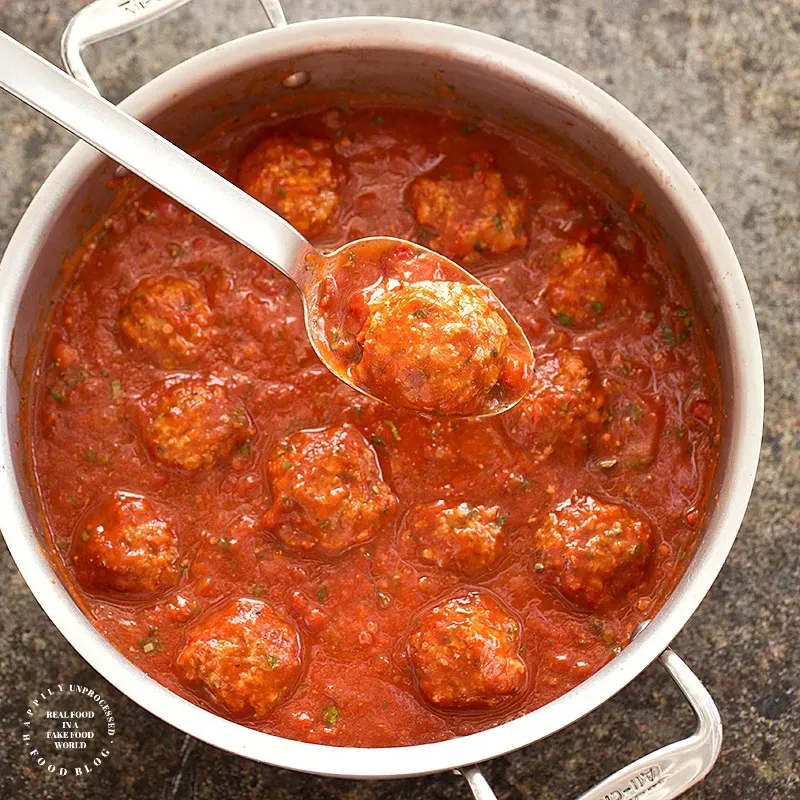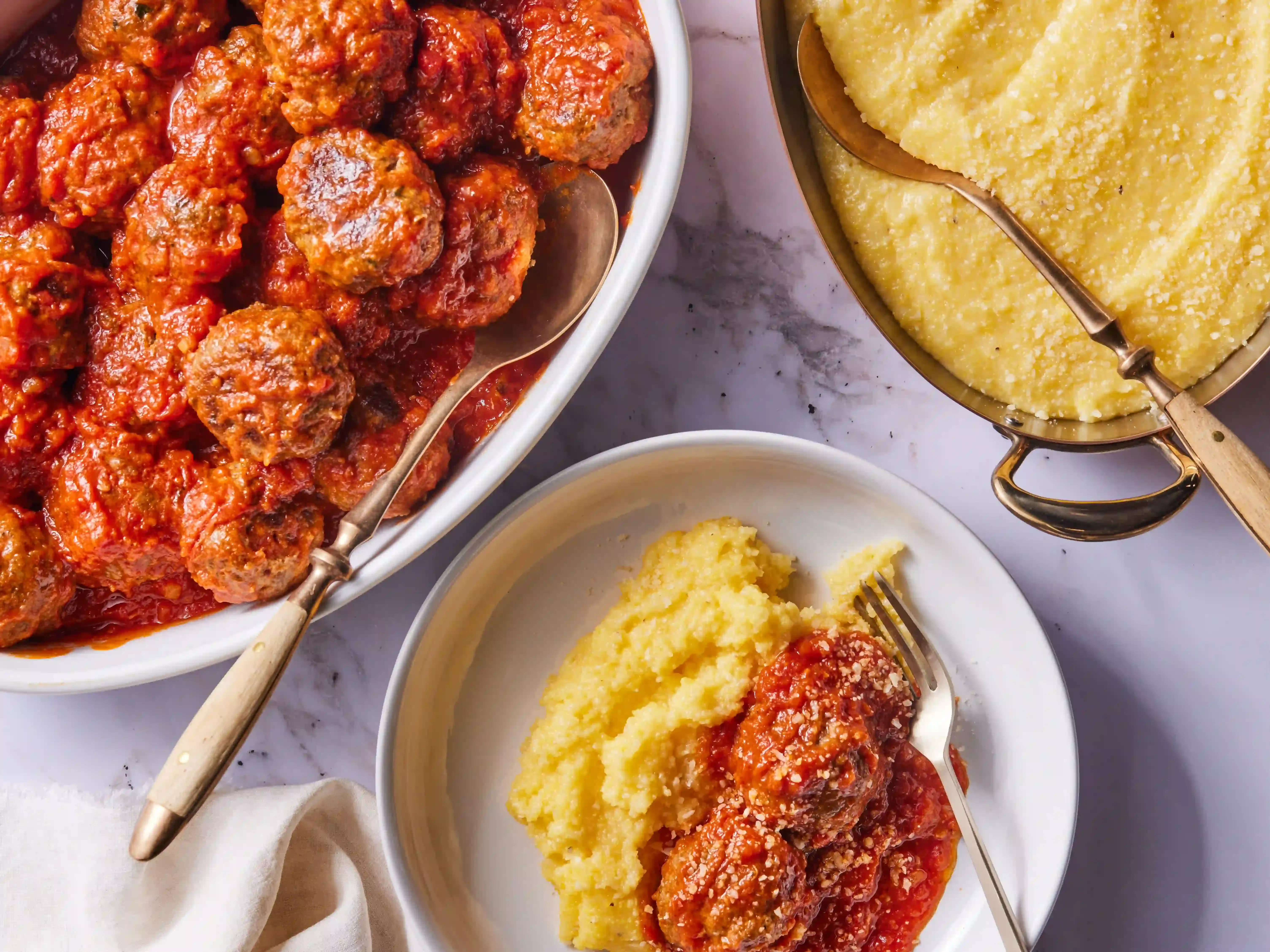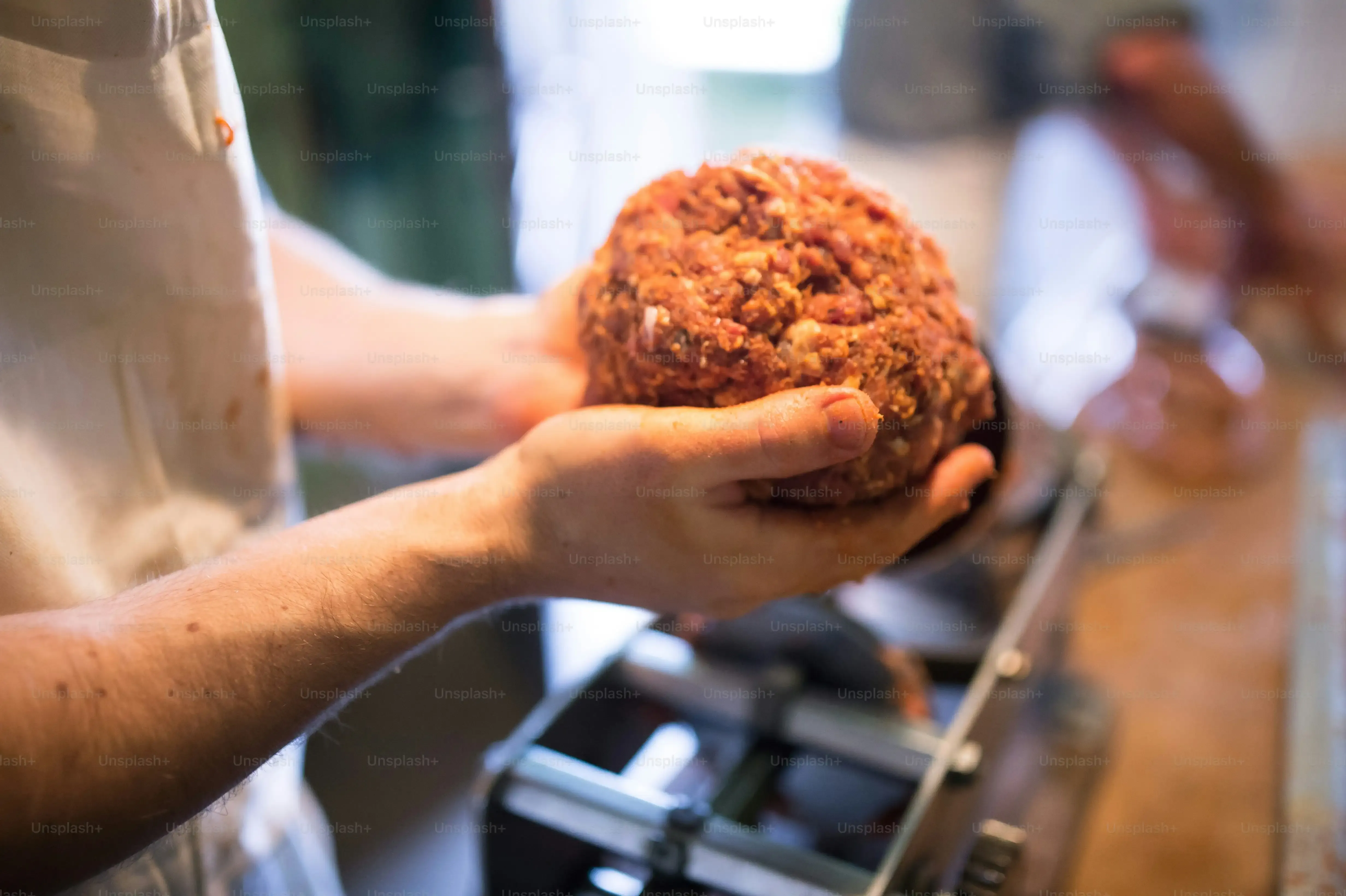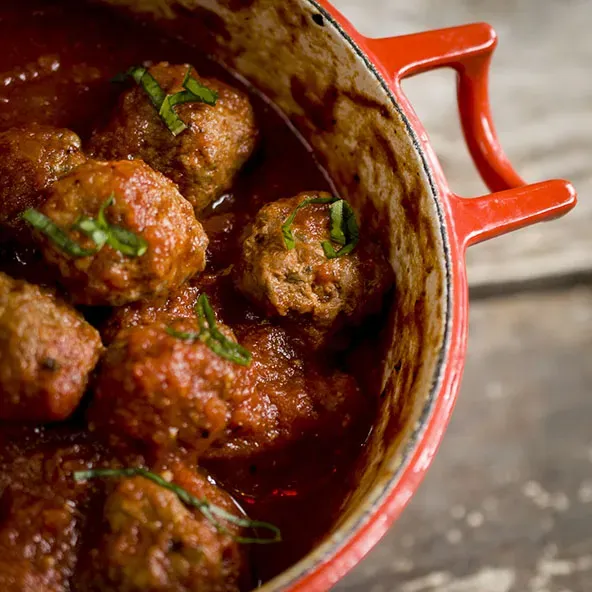Table of Contents
Let's be honest, making meatballs can feel like a production. You mix, you roll, and then comes the splatter-zone known as pan-frying. Your kitchen smells like a greasy spoon for days, and you spend half the evening scrubbing oil off everything. There has to be a better way, right? Turns out, there is. Baking delivers that same delicious, tender meatball without the mess and the fuss. We're diving into a fantasticbaked italian meatball recipe food networkstyle today, inspired by the kind of simple, flavorful cooking that just works.
Why Bake? The Appeal of This Italian Meatball Recipe from Food Network

Why Bake? The Appeal of This Italian Meatball Recipe from Food Network
Tired of the Fryer Fiasco?
Let's cut to the chase: Frying meatballs is a mess. You heat up a pan of oil, which inevitably spatters tiny, hot grease droplets onto your stove, your counter, maybe even your shirt. You have to stand there, flipping each little orb, hoping they brown evenly without burning. Then, you're left with a pan full of used oil you need to deal with, and a lingering fried smell that hangs around like an unwelcome guest. Honestly, who needs that kind of stress when you're trying to make a comforting meal? This is exactly why abaked italian meatball recipe food networkstyle is a game changer.
The Oven: Your New Meatball Buddy
Baking flips the script entirely. You shape your meatballs, pop them on a sheet pan, and slide them into a hot oven. That's pretty much it. No standing, no flipping, minimal splattering. The heat surrounds the meatballs, cooking them through evenly, giving them a nice crust without drowning them in oil. It frees you up to actually do something else, like make the sauce or, you know, sit down for five minutes. It’s a cleaner, more hands-off approach that delivers consistently tender results, which is the real win here.
So, what are the main advantages of baking over frying?
- Less mess and splatter
- No need to manage hot oil
- Even cooking throughout
- More hands-off cooking time
- Often results in more tender meatballs
Ingredients and Prep for Your Baked Italian Meatballs

Ingredients and Prep for Your Baked Italian Meatballs
Getting the Right Meat Mix and Binder
Alright, let's talk meat. A classic Italian-American meatball, like the kind you'd find inspiring a goodbaked italian meatball recipe food networkmight feature, usually isn't just one type of ground meat. A blend of beef and pork gives you the best of both worlds: beef brings the flavor depth, and pork adds fat for tenderness. Sometimes veal makes an appearance too, for a lighter texture, but beef and pork is your solid starting point. You want maybe an 80/20 or 85/15 fat ratio for beef; too lean and your meatballs turn into sad, dry pucks. For the binder, you're looking at bread crumbs, often soaked in milk or water. This isn't just filler; it keeps things moist and light. An egg acts as the glue, holding it all together.
Flavor Builders: Onion, Garlic, Cheese, and Herbs
Nobody wants a bland meatball. This is where your aromatics and cheese come in. Finely diced onion, cooked down a bit first, adds sweetness and depth without being crunchy. Raw garlic is potent; cooked garlic is mellow and fragrant. Don't skimp here. Parmesan cheese is non-negotiable – it brings that salty, umami punch. Fresh parsley is key for brightness, and maybe a pinch of dried Italian herbs like oregano and basil. Salt and pepper, obviously. Some folks add a pinch of nutmeg too, which sounds weird but works wonders in savory meat dishes.
- Ground Beef (80/20 or 85/15 fat ratio)
- Ground Pork
- Bread Crumbs (plain or Italian seasoned)
- Milk or Water
- Egg(s)
- Onion (finely diced, preferably cooked)
- Garlic (minced)
- Parmesan Cheese (grated)
- Fresh Parsley (chopped)
- Salt and Black Pepper
- Optional: Dried Italian Herbs, Nutmeg
Mixing and Letting it Chill Out
Now for the hands-on part. Combine all your ingredients in a large bowl. Here’s the crucial bit: mix gently. Overworking the meat develops the protein too much, resulting in tough meatballs. Use your hands, a fork, or a spatula, but treat the mixture kindly. Combine just until everything is incorporated. Once mixed, cover the bowl and pop it in the fridge for at least an hour. This chilling time is not optional. It allows the flavors to meld, the bread crumbs to fully hydrate, and makes the mixture much easier to handle and roll into balls. Trying to roll warm, sticky meatball mix is a frustrating exercise in futility.
Baking Your Perfect Italian Meatballs

Baking Your Perfect Italian Meatballs
Rolling Them Right: Size Matters
the meat mixture is chilled, the flavors have had a little chat, and it's time to get rolling. Don't overthink this part, but consistency is key. You want your meatballs roughly the same size so they cook evenly. Aim for something around 1 ½ to 2 inches in diameter. Think golf ball, maybe slightly smaller. Using a small scoop, like a 1 ¾-inch ice cream scoop, can help keep things uniform. Once you scoop, gently roll them between your palms to smooth them out. Don't pack them super tight; a light touch keeps them tender. Place them on a baking sheet lined with parchment paper or foil. Parchment paper is your friend here – it prevents sticking and makes cleanup ridiculously easy, which is exactly what you want from abaked italian meatball recipe food networkstyle experience.
Into the Hot Zone: Temperature and Time
Now for the magic. Preheat your oven to a solid 400°F (200°C) or even 425°F (220°C) if your oven runs a little cool. A hotter oven helps them brown nicely on the outside while staying juicy inside. Pop the baking sheet into the hot oven. How long do they need? It depends on their size, but generally, you're looking at 15 to 25 minutes. You'll know they're done when they're browned on the outside and cooked through. Cut one open if you're unsure – the inside should be opaque and no longer pink. Resist the urge to crowd the pan; give them some space so they can brown instead of steam.
Quick Baking Checklist:
- Roll meatballs to uniform size (1.5-2 inches).
- Use a scoop for consistency if you have one.
- Don't overwork the mixture when rolling.
- Place on a parchment-lined baking sheet.
- Preheat oven to 400-425°F (200-220°C).
- Bake for 15-25 minutes, depending on size.
- Meatballs are done when browned and cooked through.
- Avoid crowding the baking sheet.
Serving Suggestions for Food Network's Baked Meatballs

Serving Suggestions for Food Network's Baked Meatballs
The Classic Move: Sauce and Pasta
let's state the obvious first. The most classic way to serve up your beautifulbaked italian meatball recipe food networkcreations is swimming in a rich, homemade tomato sauce. A good Sunday gravy, slow-simmered with maybe a little sausage or pork neck bone for extra flavor, is the dream. Gently drop the baked meatballs into the simmering sauce during the last 20-30 minutes of cooking. This lets them soak up all that deliciousness and become even more tender. Serve them over your favorite pasta – spaghetti is traditional, but rigatoni or tagliatelle work beautifully too. Don't forget a generous sprinkle of fresh Parmesan and maybe some torn basil leaves on top. It’s simple, comforting, and utterly satisfying.
Thinking Beyond the Spaghetti Bowl
While pasta is a go-to, these baked meatballs are versatile. Think about meatball subs! Pile them into a crusty hero roll, ladle on some sauce, and maybe add a slice of provolone or mozzarella and pop it under the broiler until the cheese is bubbly and melted. Or, serve them alongside creamy polenta – the soft polenta is perfect for soaking up the sauce and the meatballs. They also work great as appetizers; just serve them warm in a slow cooker with sauce for a party. You can even slice them up cold for sandwiches the next day. Don't limit yourself to just one way; these little guys are ready for action.
Here are a few ways to serve those baked beauties:
- With spaghetti and marinara sauce
- On a crusty hero roll for a meatball sub
- Alongside creamy polenta
- As appetizers in a slow cooker with sauce
- Sliced cold in a sandwich
- Over mashed potatoes (don't knock it 'til you try it)
Storing Leftover Baked Italian Meatballs

Storing Leftover Baked Italian Meatballs
Keeping Them Fresh in the Fridge
Alright, you've made a batch of gloriousbaked italian meatball recipe food networkstyle meatballs, maybe you even made extra on purpose (smart move). Now, how do you keep those precious leftovers from turning into something sad and questionable in the back of your fridge? The key is airtight. Once they've cooled down completely – and I mean completely, don't trap steam in there – get them into a container that seals well. Glass containers are great, or sturdy plastic ones. They'll hang out happily in the refrigerator for about 3 to 4 days. Any longer, and you're pushing your luck. Nobody wants a science experiment where dinner used to be.
- Cool completely before storing.
- Use airtight containers or heavy-duty zip-top bags.
- Store in the refrigerator for up to 3-4 days.
- Label with the date if you're prone to forgetting.
Freezing for the Long Haul
Planning ahead or just ended up with way too many? Freezing is your friend for long-term storage of your baked Italian meatballs. You have a couple of options here. You can freeze them plain first – spread the cooled meatballs on a baking sheet and pop them in the freezer until solid, then transfer them to a freezer bag or container. This prevents them from sticking together in one giant meatball brick. Or, you can freeze them already in sauce. Let the meatballs and sauce cool, then portion them into freezer-safe containers or bags. Freezing in sauce helps protect them from freezer burn and keeps them moist. Frozen meatballs are good for about 3 to 4 months. Beyond that, quality starts to decline, though they're technically safe for longer.
Bringing Them Back to Life
When you're ready to eat those stored meatballs, don't just nuke them into oblivion. If they were frozen in sauce, the easiest way is to thaw them overnight in the fridge and then gently reheat them in a pot on the stove over low heat. If they were frozen plain, you can add them directly to simmering sauce (they might take a little longer to heat through) or reheat them gently in the oven at a lower temperature (around 300-325°F or 150-160°C) until warmed through. Microwaving is an option for a quick single serving, but do it in short bursts to avoid tough spots. Gentle reheating is key to maintaining that tender texture you worked for.
Ditch the Splatter, Embrace the Bake
So there you have it. You've skipped the greasy pan, avoided oil splatters up the arm, and still ended up with a batch of perfectly tender, deeply flavorful Italian meatballs. Thisbaked italian meatball recipe food network-inspired approach proves you don't need to make a mess to make magic happen in the kitchen. Whether they're simmering in Sunday sauce or starring in a weeknight sub, these baked beauties deliver on taste without the usual fuss. Keep this method in your back pocket; your stove (and your shirt) will thank you.